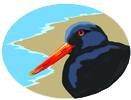Dark-eyed Juncos are definitely one for the taxonomy lumpers. These finches used to be four different species, but were found to interbreed and so were lumped together in 1973. The most common dark-eyed in our area is the subspecies called Oregon Junco. This five and a half inch bird has a large pink bill, black hood, brown back, white belly, and distinctive white outer tail feathers that flash scissor-like when it flies. It lives here year round.
Dark-eyed Juncos are seen on the forest floor and along mountain roadsides and trails. They forage by hopping back and forth in place on the ground, exposing seeds and insects. In the winter, they join mixed flocks of chickadees, nuthatches, and sparrows. These winter flocks have distinctive social rankings and exclusive feeding territories. Speaking of feeding, John James Audubon noted that their flesh was extremely juicy.
Breeding season is the only time you see them in pairs. Their nest is normally on the ground in a shallow depression with an overhead protection. It is made of coarse grass, roots and moss, usually lined with fur. The female lays three to five eggs. The young are fed only insects. Nestlings’ legs develop rapidly to allow them to run from danger before they are able fly.
So the next time you see a white scissor-like flash on the ground you'll know it's the Dark-eyed Junco.
Dark-Eyed Junco photo uncredited


